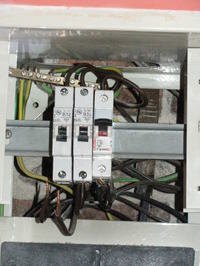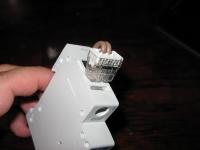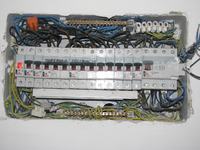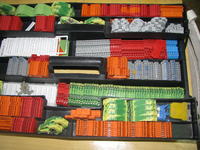Dear,
I found old threads about this both here and on the sep forum. Some people even proved by loading with weights that you can connect up to 3 wires of the same cross-section, and others that this should be avoided like the plague.
From my tests on 2.5mm cables, it turned out that two (I note: of the same cross-section) hold very well and three poorly. (If they stick tightly, it's only apparently, one can be easily moved and removed). Twisting here doesn't help, it even makes it worse, they all move. Maybe soldering twisted...
Anyway, are there any professional methods for this? One of the regular users of this forum said that WAGO connectors. how? So loose over the switch?
I also found these small insulated strips on the net:
http://www.empiriakk.pl/lpi-6_czarna_listwa_rzylaczeńowa_izolacyjna_a18-0038,428,3555.html
http://www.empiriakk.pl/lpi-14_czarna_listwa_przyl_izol_a18-1038,428,3559.html
but it takes up one field in the switchgear.
It's important to be insulated. In Castorama, Leroy and Grognie they have only blue and yellow non-insulated.
Any other suggestions?
I found old threads about this both here and on the sep forum. Some people even proved by loading with weights that you can connect up to 3 wires of the same cross-section, and others that this should be avoided like the plague.
From my tests on 2.5mm cables, it turned out that two (I note: of the same cross-section) hold very well and three poorly. (If they stick tightly, it's only apparently, one can be easily moved and removed). Twisting here doesn't help, it even makes it worse, they all move. Maybe soldering twisted...
Anyway, are there any professional methods for this? One of the regular users of this forum said that WAGO connectors. how? So loose over the switch?
I also found these small insulated strips on the net:
http://www.empiriakk.pl/lpi-6_czarna_listwa_rzylaczeńowa_izolacyjna_a18-0038,428,3555.html
http://www.empiriakk.pl/lpi-14_czarna_listwa_przyl_izol_a18-1038,428,3559.html
but it takes up one field in the switchgear.
It's important to be insulated. In Castorama, Leroy and Grognie they have only blue and yellow non-insulated.
Any other suggestions?








